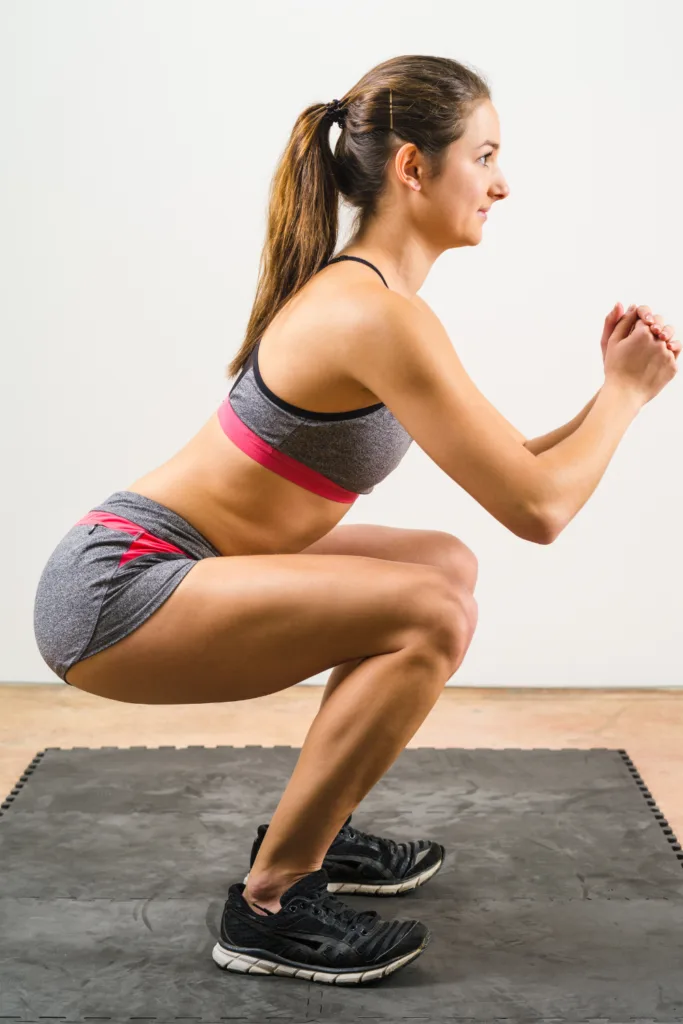Ever found yourself bobbing up and down during an exercise and thought: “What is this even doing?”
You may be familiar with pulsing if you do yoga, Pilates or barre, but when it comes to running, pulsing is a pretty unfamiliar concept.
Exercises like pulse squats use a pulsing motion to bring some pretty big benefits.
When done as part of a pre-run warm up or a strength training session, they can be pretty game changing.
So what exactly are pulse squats and why should you be doing them?
Also, are there any other squat variations that you should be trying as a runner?
In this guide we’ll look at:
- What is a pulse squat?
- What muscles do pulse squats work?
- What are the benefits of pulse squats?
- How to do pulse squats
- 12 squat variations to try before your next run
Ready?
Let’s get going!

What is a pulse squat?
A pulse squat is a variation of the basic air squat.
It requires you to pulse up and down once during the bottom portion of the squat exercise.
By pulsing up and down, you create tension in the lower body which challenges the muscles in your legs.
It is for this reason that a pulse squat can feel more difficult than a standard bodyweight squat.
Related: The ultimate 30 day strength training plan for runners
What muscles do pulse squats work?
Pulse squats work the following muscles:
- Glutes
- Hamstrings
- Quads
- Calves
- Hip flexors
- Abdominals
- Obliques
- Abductors and adductors
By pulsing up and down these muscles are in a lengthened position and are placed under prolonged tension.
Related: 7 of the best glute strength exercises for runners

What are the benefits of pulse squats?
Compared with standard bodyweight squats, pulse squats have the following benefits:
#1 Increase muscular strength and endurance
Because muscles are placed under increased tension during a pulsing exercise, this helps to build their strength and endurance.
Pulsing isolates the active muscles and fatigues them more quickly, which helps to make them stronger.
It also increases blood circulation to the muscles in the legs, which helps with muscle growth.
#2 Improve stability and coordination
By performing squats, you will activate multiple muscle groups throughout the body, including those in your legs, lower back, core and even shoulders.
These movements help to improve your stability and coordination for the whole body.
#3 Shorten your stride length
Pulse squats may help to shorten your stride length – that is the distance between the toe of one foot to the toe of your other foot as you run.
Because a pulse squat works your quads, glutes and hamstrings, therefore making them stronger, this can help to shorten your stride length.
A shorter stride length has benefits for your running form and performance.
One 2014 study found that a reduced stride length reduces the magnitude of several key biomechanical factors associated with running injuries.
#4 Improve hip mobility and ankle strength
Pulse squats help to improve hip mobility and flexibility which are both incredibly important for runners.
Your hips play a crucial role in running to give you balance and drive.
Your hips are connected to the key muscles in your core and legs, so if they’re not moving efficiently or they’re stiff, your running form and performance will be negatively impacted.
Pulse squats also help to improve ankle strength which is often an underrated aspect of running form.
Ankle strength is particularly important when sprinting and jumping.
#5 Help to burn more calories
As part of a HIIT workout, pulse squats help to burn more calories as they place your muscles under constant engagement.
This means the fibres in your muscles don’t have time to rest and remain contracted throughout the exercise – which leads to higher calories burned.
Related: 5 dynamic hip flexor stretches for runners + how to do them
How to do pulse squats
- Stand and place your feet hip width apart.
- Make sure your feet are rotated slightly externally.
- Engage your core and start to squat down. Push your hips back and bend at the knee. Push your knees outwards to prevent them caving in.
- Stop when you are just below parallel with the ground. This is your starting position.
- Drive up by pushing from your ground through your heels, stopping when you reach one quarter of the way to standing.
- Squat back down to parallel, making sure you keep a neutral spine throughout. This is one rep.
- Repeat 15 to 20 reps.
Related: Does running make your butt bigger? 20 butt building exercises
12 squat variations to try before your next run
Now you know more about pulse squats, here are 10 squat variations to try before your next run either as part of a pre-run warm up or a strength training session.
#1 Squat with calf raise
#2 Sumo squat
#3 Medicine ball squat and toss
#4 Bulgarian split squat
#5 Jump squat
#6 Touchdown squat
#7 Banded squat
#8 Goblet squat
#9 Dumbbell squat
#10 Squat to overhead press
#11 Back squat
#12 Single leg squat
Related: 9 best bodyweight exercises for runners
- 5 things I wish I’d known before returning to running - March 3, 2024
- Running 20 minutes a day: Benefits + how to start - January 27, 2024
- How to run your first 2 hour half marathon - January 16, 2024
